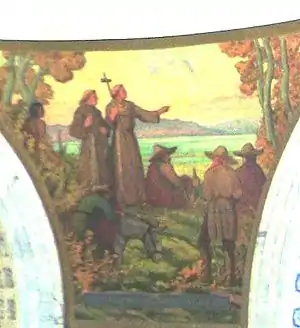Silvestre Vélez de Escalante
Silvestre Vélez de Escalante (flourished 1768–1779[1]) was a Franciscan missionary and explorer of the Southwest United States during the late 18th century. He is known for his journal, in which he described the expeditions he went on. These included a failed overland expedition in 1776.


Domínguez–Escalante expedition
Escalante and his superior Francisco Atanasio Domínguez, cartographer Don Bernardo Miera y Pacheco, and eight others left from Santa Fe, New Mexico trying to reach Monterey, California (they were joined soon after by 2 more), during which they passed through what is now southwest Colorado and Utah—where they were the first white men to travel—[2] through the east side of the Great Basin, and returned to Santa Fe by way of Arizona, skirting the eastern portion of the Grand Canyon, and passing through the badlands of western New Mexico.[3]
Escalante namesakes include Escalante Desert, Escalante River, Escalante (town), Grand Staircase-Escalante National Monument, and the Escalante Elementary & High schools (Rio Arriba County, New Mexico).
References
- "Silvestre Vélez de Escalante". Encyclopædia Britannica. 20 March 2019. Retrieved 26 July 2019.
- Katieri Treimer, Site research report, site no. 916, Southwest Colorado, Earth Metrics Inc. and SRI International for Contel Systems and the U.S. Air Force 1989
- "Dominquez and Escalante Expedition, 1776". UintahBasintah.org. Retrieved 2010-11-16. (cites: Waner, T, ed. (1995), The Dominguez and Escalante Journal, translated by Chavez, A, Salt Lake City: University of Utah Press, ISBN 9780874804485)
External links